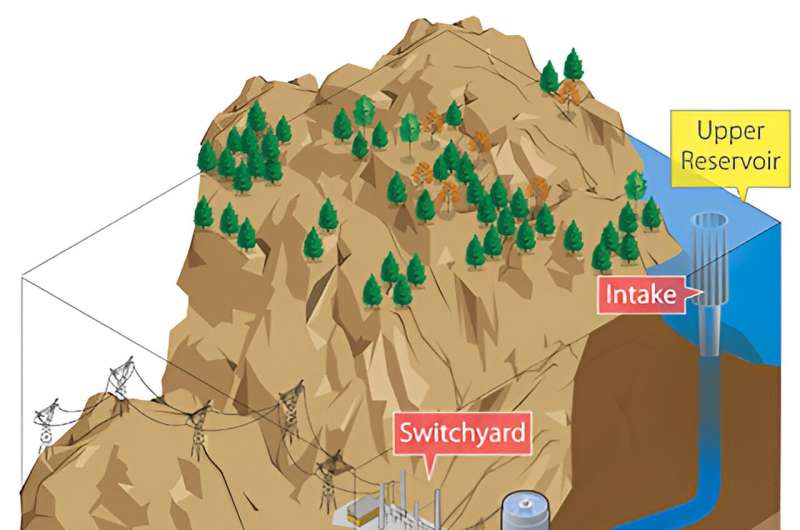This article has been reviewed according to Science X's editorial process and policies. Editors have highlighted the following attributes while ensuring the content's credibility:
fact-checked
peer-reviewed publication
trusted source
proofread
Analysis reveals benefits of hydropower for grid-scale energy storage

Closed-loop pumped storage hydropower systems rank as having the lowest potential to add to the problem of global warming for energy storage when accounting for the full impacts of materials and construction, according to analysis conducted at the U.S. Department of Energy's (DOE's) National Renewable Energy Laboratory (NREL). These systems rely on water flowing between two reservoirs to generate and store power.
These findings, reported in the journal Environmental Science and Technology, provide previously unknown insight into how closed-loop pumped storage hydropower—which is not connected to an outside body of water—compares to other grid-scale storage technologies.
Increasing the energy storage capacity can support a higher amount of renewable energy generation on the electric grid. Because renewable sources such as wind and solar do not generate electricity continuously, there is the risk of curtailment, where excess electricity is produced but cannot be used. Storage will help this excess electricity generation and provide a buffer between supply and demand, ensuring that more renewable electricity makes its way to consumers.
The paper, "Life Cycle Assessment of Closed-Loop Pumped Storage Hydropower in the United States," was written by Daniel Inman, Gregory Avery, Rebecca Hanes, Dylan Hettinger, and Garvin Heath, all of whom are with NREL's Strategic Energy Analysis Center.
"Closed-loop pumped storage hydropower is shown to be the smallest emitter of greenhouse gases," Inman said.
The researchers analyzed the global warming potential (GWP) of energy storage technologies, which currently stand as a bottleneck that inhibits the end use of renewable electricity generation. Storage can help increase the grid's ability to accommodate renewables such as wind and solar. Pumped storage hydropower stands out as an established technology, but limited information is available about greenhouse gas emissions associated with its use. The NREL study provides a life cycle assessment of new closed-loop pump storage hydropower in the United States and assesses its GWP.
Pumped storage hydropower is compared against four other technologies: compressed-air energy storage (CAES), utility-scale lithium-ion batteries (LIBs), utility-scale lead-acid (PbAc) batteries, and vanadium redox flow batteries (VRFBs). Pumped-storage hydropower and CAES are designed for long-duration storage, while batteries are intended to be used for a shorter time frame.
"Not all energy storage technologies provide the same services," Inman said. "We looked at compressed-air energy storage, which allows for grid-scale energy storage and provides services like grid inertia and resilience. But pumped storage hydropower is about a quarter of the greenhouse gas emissions compared to compressed air."
In examining pumped storage hydropower, the researchers modeled their findings based on 39 preliminary designs from 35 proposed sites in the contiguous United States. The average closed-loop pump storage hydropower facility was assumed to have storage capacity of 835 megawatts and an average estimated 2,060 GWh of stored energy delivered annually. The base scenario also assumed the electricity mix would entirely come from renewable technologies.
The researchers calculated the GWP attributed to 1 kWh of stored electricity delivered to the nearest grid substation connection point. They estimated the GWP for pumped storage hydropower ranges from the equivalent of 58 to 502 grams of carbon dioxide per kWh.
Hydropower offered the lowest GWP on a functional unit basis, followed by LIBs, VRFB, CAES, and PbAc. They also determined certain decisions can have a substantive impact. For example, building on a brownfield rather than a greenfield site can reduce the GWP by 20%.
More information: Timothy R. Simon et al, Life Cycle Assessment of Closed-Loop Pumped Storage Hydropower in the United States, Environmental Science & Technology (2023). DOI: 10.1021/acs.est.2c09189

















